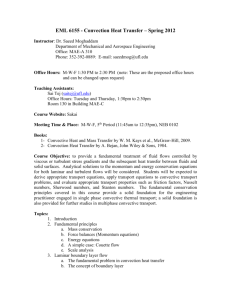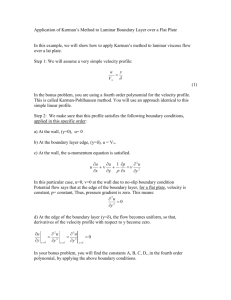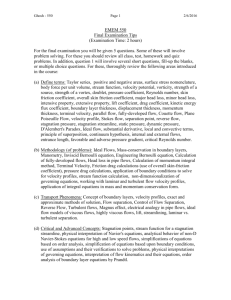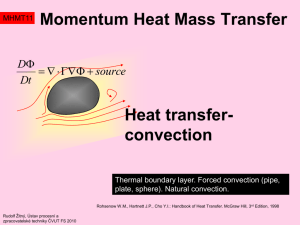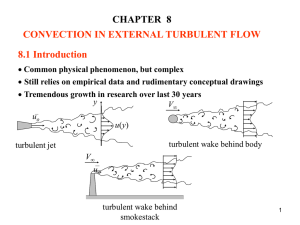Introduction to convection heat transfer
advertisement
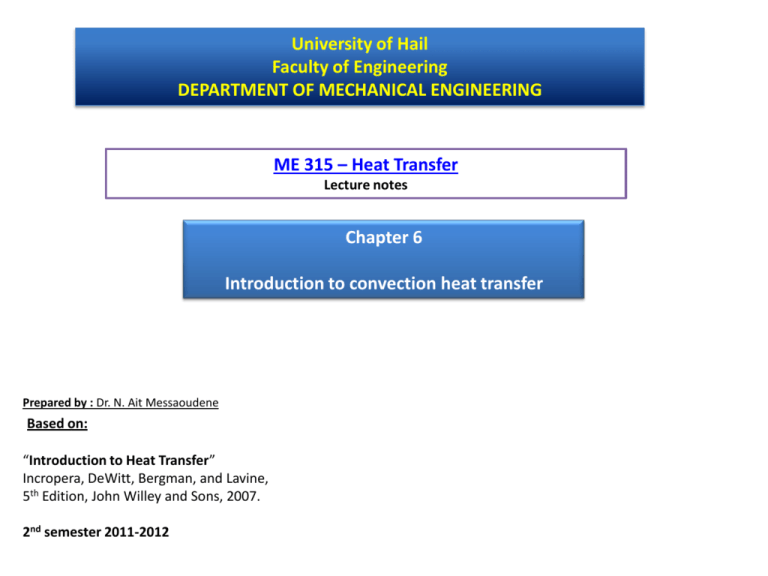
University of Hail Faculty of Engineering DEPARTMENT OF MECHANICAL ENGINEERING ME 315 – Heat Transfer Lecture notes Chapter 6 Introduction to convection heat transfer Prepared by : Dr. N. Ait Messaoudene Based on: “Introduction to Heat Transfer” Incropera, DeWitt, Bergman, and Lavine, 5th Edition, John Willey and Sons, 2007. 2nd semester 2011-2012 The Convection Boundary Layers • Velocity Boundary Layer – A consequence of viscous effects associated with relative motion between a fluid and a surface. – A region of the flow characterized by shear stresses and velocity gradients. – A region between the surface and the free stream whose thickness δ increases in the flow direction. δ – Manifested by a surface shear stress τs local friction coefficient Cf and drag force, FD . FD s dAs As • Thermal Boundary Layer – A consequence of heat transfer between the surface and fluid. – A region of the flow characterized by temperature gradients and heat fluxes. – A region between the surface and the free stream whose thickness increases in the flow direction. – Manifested by a surface heat flux qs” and a convection heat transfer coefficient h . t Ts T y Ts T 0.99 Local and Average Convection Coefficients • Local Heat Flux and Coefficient: • Average Heat Flux and Coefficient for a Uniform Surface Temperature: q hAs Ts T q As qdAs Ts T A hdAs s h 1 hdAs As As • For a flat plate in parallel flow: 1 h oL hdx Per unit width L Laminar and Turbulent Flow Laminar and Turbulent Velocity Boundary Layers • Transition criterion for a flat plate in parallel flow: Laminar and Turbulent Thermal Boundary Layers • Effect of transition on boundary layer thickness and local convection coefficient: 105 Re x ,c 3 x 106 ~ ~ The Boundary Layer Equations Consider concurrent velocity and thermal boundary layer development for steady, twodimensional, incompressible flow with constant fluid properties and negligible body forces. boundary layer approximations. Velocity Boundary Layer: The velocity equations are uncoupled from the energy (temperature) equation. + Proper BC Thermal Boundary Layer: Solve for u, v and T Cf and h Solving these equations requires methods that go beyond the scope of the present course. Laminar compressible BL involve even more complicated equations which are moreover coupled The case of turbulent BL gets even more complicated with the introduction of new terms (due to turbulent mixing) requiring special mathematical models. Boundary Layer Similarity As applied to the boundary layers, the principle of similarity is based on determining similarity parameters that facilitate application of results obtained for a surface experiencing one set of conditions to geometrically similar surfaces experiencing different conditions. • Dependent boundary layer variables of interest are: s and q or h Functional Form of T, u and ND parameters N.D variables Nusselt Number ND Equations and BC Physical Interpretation of the Dimensionless Parameters Key similarity parameters may be deducted from the ND form of the momentum and energy equations. The Prandtl number provides a measure of the relative effectiveness of momentum and Reynolds Number Prandtl Number energy transport by diffusion in the velocity and thermal boundary layers, respectively. Pr ≈ 1 for gases Pr << 1 for liquid metals Pr >> 1 for oils Inertia forces Viscous forces Momentum diffusivity Thermal diffusivity Pr strongly influences the relative growth of the velocity and thermal boundary layers. Momentum and Heat Transfer Analogy: The Reynolds Analogy Momentum and Heat Transfer Equivalence of dimensionless momentum and energy equations for negligible pressure gradient (dp*/dx*~0) and Pr~1: * u* 1 2u * * u u v * * x y Re y*2 * Convection terms Diffusion T 1 T * T v x* y* Re y*2 * u* u* T * * 2 * u * y * y* 0 T * * y Cf and Nu are analogous y* 0 Reynolds analogy introduce If the velocity parameter is known, the analogy may be used to obtain the heat transfer parameter, and vice versa. But this analogy is restricted to (dp*/dx*~0) and Pr~1. A modified form may be applied over a wide range of Pr: Applicable to laminar flow if dp*/dx* ~ 0. But Generally applicable to turbulent flow without restriction on dp*/dx*. Colburn j factor for heat transfer Problem 6.19: Determination of heat transfer rate for prescribed turbine blade operating conditions from wind tunnel data obtained for a geometrically similar but smaller blade. The blade surface area may be assumed to be directly proportional to its characteristic length As L . SCHEMATIC: ASSUMPTIONS: (1) Steady-state conditions, (2) Constant properties, (3) Surface area A is directly proportional to characteristic length L, (4) Negligible radiation, (5) Blade shapes are geometrically similar. L h 2 1 h1 L2 q2 L1 q1 L2 A1 Ts,1 T Ts,2 T 400 35 q1 1500 W Ts,1 T 300 35 Problem 6.26: Use of a local Nusselt number correlation to estimate the surface temperature of a chip on a circuit board. SCHEMATIC:
